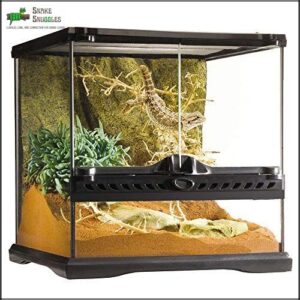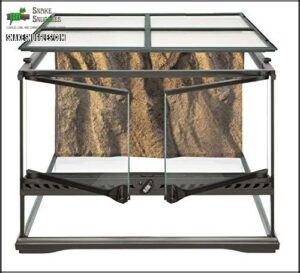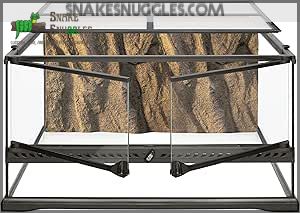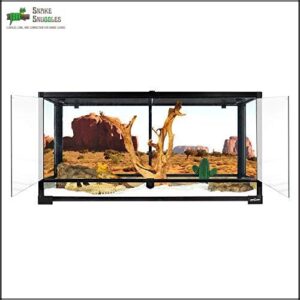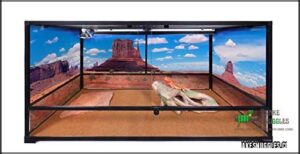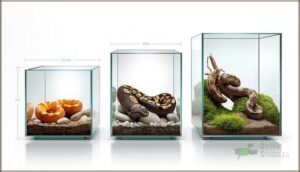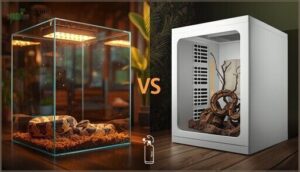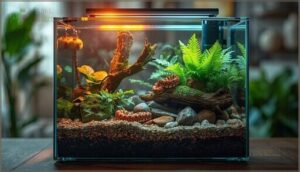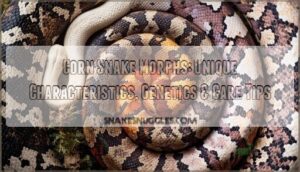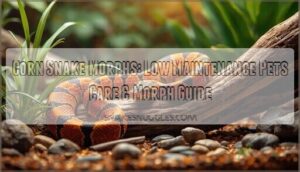This site is supported by our readers. We may earn a commission, at no cost to you, if you purchase through links.
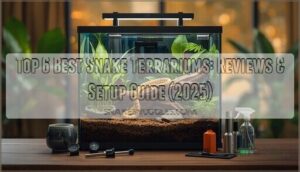
Your snake’s terrarium isn’t just a tank—it’s the foundation of their health, behavior, and lifespan. Get it wrong, and you’ll spend months troubleshooting stress, respiratory issues, and escape attempts. Get it right, and you’ll watch your snake thrive with the confidence that comes from nailing the details.
The difference often comes down to choosing the best snake terrariums with the right dimensions, materials, and features for your species. Whether you’re housing a corn snake that needs lateral space or a boa that demands humidity control, the enclosure you pick shapes everything from feeding behavior to temperature regulation.
Finding one that balances functionality, durability, and your snake’s specific needs takes knowing what separates a mediocre setup from one that actually works.
Table Of Contents
Key Takeaways
- Your snake’s terrarium size should match their adult length with proper floor space—corn snakes need at least 48″×24″, ball pythons need 8 square feet minimum, and large boas require 6′×3′ to allow natural movement and reduce stress.
- PVC enclosures retain heat 3-4 times better than glass and cost less to operate long-term, while front-opening doors cut maintenance time by 30% and reduce stress by approaching snakes from the side instead of overhead.
- Each species demands specific temperature gradients and humidity levels—corn snakes thrive at 65-75% humidity with 80-85°F warm zones, while ball pythons need 50-60% humidity with 88-92°F basking spots to support proper thermoregulation and shedding.
- Essential features like dual hides positioned across temperature zones, proper ventilation with 4-8 air changes per hour, and deep substrate layers (10-35cm) let your snake express natural behaviors like burrowing and thermoregulating without constant intervention.
Top 6 Best Snake Terrariums Reviewed
You need a terrarium that keeps your snake safe, comfortable, and easy to manage. The right enclosure balances solid construction with practical features like ventilation, access points, and temperature control.
Below, you’ll find six options that work well for different snake species and keeper preferences.
1. Exo Terra Reptile Glass Terrarium Kit
You’ll want a terrarium that grows with your snake. The Exo Terra Reptile Glass Terrarium Kit delivers with dual front-opening doors locked tight—no escapes on your watch.
The raised bottom frame fits substrate heaters perfectly, while stainless steel mesh on top lets UVB and heat lamp rays penetrate completely.
Available in sizes from 18×18×24 inches up to 36×18×24 inches, this glass terrarium gives you wire inlets for sensors and a waterproof base for humidity control.
Over 75,000 keepers trust Exo Terra’s proven reptile habitat design.
Best For: Snake keepers who need a secure, well-ventilated glass terrarium with front access and built-in heating support for small to medium-sized reptiles.
- Dual front-opening doors with escape-proof locks make feeding and cleaning easy without removing the entire top
- Raised bottom frame accommodates substrate heaters while stainless steel mesh top allows full UVB and infrared penetration
- Available in multiple sizes (18×18×24 to 36×18×24 inches) with waterproof base and wire inlets for complete habitat customization
- May struggle to hold humidity without additional equipment like humidifiers or modified ventilation
- Styrofoam background isn’t very durable and might need replacement or upgrading over time
- Heavy when fully set up with substrate and décor, making it difficult to relocate once established
2. Exo Terra Glass Reptile Terrarium
If you’re looking for a lower-profile option, the Exo Terra Glass Reptile Terrarium at 18×18×12 inches works beautifully for leopard geckos and juvenile ball pythons. This glass terrarium uses 5mm thick panels that resist scratches and showcase your bioactive setups clearly.
The full screen top lets UVB penetrate, while front-opening doors simplify terrarium maintenance—you won’t wrestle with lifting lids anymore. Its waterproof base accommodates paludarium builds, and the natural background encourages climbing behavior.
Over 88% of keepers rate Exo Terra terrariums highly for reptile housing reliability.
Best For: Keepers who want a compact, front-access glass enclosure for small terrestrial reptiles like leopard geckos or juvenile ball pythons with reliable climate control.
- Front-opening doors make feeding and maintenance way easier than top-entry tanks
- Full mesh top allows over 90% UVB and heat penetration for proper thermoregulation
- Waterproof base supports bioactive setups with substrate layers or even shallow water features
- Glass can arrive damaged during shipping, with some users reporting breakage issues
- Background can be tricky to clean thoroughly, especially in cracks and crevices
- May need extra accessories like heat lamps or mats since they’re sold separately
3. Natural Reptile Glass Terrarium Kit
For vertical-loving species like green tree pythons or young boa constrictors, the Natural Reptile Glass Terrarium Kit delivers 18×18×24 inches of climbing-friendly height. This reptile terrarium bundles everything—60-watt basking lamp, Eco Earth bioactive substrate, plastic foliage—making kit assembly straightforward for first-time keepers.
Its stainless steel mesh top resists corrosion while maximizing terrarium lighting penetration, and dual front-opening doors with snap locks prevent escapes during feeding. Glass durability matches Exo Terra standards, though you’ll still want careful unpacking. The included care guide promotes strong reptile health from day one in this vertically designed glass terrarium.
Best For: Reptile owners with vertical-loving species like green tree pythons, young boas, or arboreal geckos who want a complete starter kit with basking lamp, substrate, and décor included.
- Comes with everything you need to start—60-watt basking lamp, Eco Earth substrate, plants, and a care guide so you’re not hunting down extras
- Tall 24-inch vertical design gives climbing species plenty of room to move naturally, with stainless steel mesh that won’t rust and lets UVB light through
- Front-opening dual doors with snap locks make feeding and cleaning easy while keeping escape artists safely inside
- Some buyers receive units with cracked glass during shipping, so inspect carefully when it arrives
- Foam backgrounds can be tricky to swap out or customize without breaking
- Pricier than basic enclosures, especially if you already own lamps and accessories
4. REPTI ZOO 50 Gallon Terrarium Tank
For adult corn snakes or ball pythons, the REPTIZOO 50 Gallon Terrarium Tank offers 36×18×18 inches of floor space, well above the 5.6-square-foot minimum for a four-foot snake. Its double sliding doors simplify tank maintenance, while the removable iron mesh top accommodates reptile lighting and ventilation without blocking UVB rays.
Terrarium assembly takes about five minutes, and the metal lock boosts pet safety against escapes. The raised bottom accommodates heat mats, and black-tinted side panels reduce stress, promoting long-term snake health in this durable glass enclosure.
Best For: Keepers of adult corn snakes, ball pythons, or similar medium-sized reptiles who need secure housing with easy access for feeding and cleaning.
- Spacious 36×18×18-inch design provides ample floor space for four-foot snakes to move and thermoregulate comfortably.
- Quick five-minute assembly with double sliding doors and a secure metal lock that prevents escapes while simplifying daily maintenance.
- Raised bottom fits heat mats perfectly, and the removable mesh top allows full UVB penetration for proper reptile health.
- Screen ventilation can make it harder to maintain high humidity levels for tropical species without frequent misting.
- Some users report minor gaps between glass panels during assembly, though these rarely affect security.
- The mesh top may not support extremely heavy lighting fixtures without additional reinforcement.
5. Large Glass Reptile Terrarium Habitat
If you’re housing large snakes or multiple specimens, a spacious glass terrarium measuring 48×24×24 inches delivers roughly 120 gallons of capacity and tempered-glass construction strong enough to hold deep substrate and décor.
Full mesh tops support reptile lighting while ensuring terrarium ventilation, and dual front-opening doors with showcase-style locks give you easy habitat security.
The waterproof base prevents leaks during high-moisture setups, and raised frames let you slide heat mats underneath.
Large enclosures like these suit adult corn snakes, ball pythons, and other species that benefit from extended floor space and climbing room.
Best For: Keepers of large snakes like adult ball pythons or corn snakes who need a spacious, escape-proof habitat with room for climbing, deep substrate, and flexible humidity control.
- Dual front-opening doors with showcase locks make feeding and maintenance safer while preventing escapes from strong or curious snakes.
- Waterproof base and raised frame let you run high-moisture bioactive setups or install under-tank heaters without damaging furniture.
- Full mesh top supports multiple lighting fixtures—UVB strips, basking bulbs, ceramic emitters—across the entire 48-inch length for proper heating gradients.
- At 73 pounds assembled, the terrarium is heavy and awkward to move or reposition without help.
- Some users report thin glass panels cracking during shipping or assembly, especially on non-tempered sections.
- Suction cups and door locks may require adjustment or replacement if installed incorrectly, leading to poor adhesion or security issues.
6. ReptiChip Coconut Chip Reptile Substrate
A 72-quart compressed brick of coconut chip substrate delivers outstanding humidity control and odor management without sacrificing reptile safety. ReptiChip expands when you add water, creating a dust-free, mold-resistant layer that holds moisture far longer than traditional bedding—you’ll spray once weekly instead of daily.
The organic coconut benefits include zero parasites and low mineral content, making it ideal for ball pythons and corn snakes in both glass and PVC snake terrariums.
At $34.95, it’s a smart investment in substrate quality and long-term reptile care.
Best For: Reptile owners who want a low-maintenance, humidity-retaining substrate that’s safe for ball pythons, corn snakes, and other tropical species without the dust or frequent misting hassles.
- Holds moisture incredibly well—most users only need to mist once a week instead of daily, making humidity management effortless.
- Dust-free and parasite-free right out of the package, so you skip the baking or freezing prep and reduce respiratory risks for your reptiles.
- One 72-quart brick lasts a long time and controls odors effectively, saving you money and cleaning time compared to aspen or soil.
- The $34.95 price tag is higher than basic substrates like aspen shavings or paper towels, which might be a stretch for budget-conscious keepers.
- It can kick up dust during the initial expansion process, so you’ll want to handle it carefully and maybe do it outside or in a ventilated area.
- Not ideal for deep-burrowing species since the chips don’t compact as firmly as sand or soil-based substrates.
Choosing The Right Terrarium Size
Getting the size right isn’t just about your snake fitting inside—it’s about giving them room to move, explore, and feel secure throughout their entire life. A cramped enclosure stresses snakes out and limits their natural behaviors, while too much space can make younger snakes feel exposed and anxious.
The right terrarium size gives your snake room to move and feel secure, while too little space stresses them out and too much makes younger snakes anxious
Let’s break down how to match tank size to your specific snake species, what minimum dimensions you actually need, and why measuring your available space matters before you commit to a purchase.
Matching Terrarium Size to Snake Species
Your snake’s adult length dictates everything about terrarium space planning—matching enclosure dimensions to species size charts isn’t optional. Corn snakes stretching 4-5 feet need different footprints than ball pythons, even at similar lengths, because climbing matters for one species more than the other.
Modern animal welfare standards emphasize that proper terrarium design lets your snake fully extend, turning adequate snake care and maintenance into observable natural behavior. Proper enclosure size guidelines, such as those for minimum space requirements, are vital for ensuring the well-being of snakes.
Minimum Space Requirements for Adult Snakes
Think of enclosure standards as your snake’s non-negotiable living contract—falling short compromises health. For adult snake care, you need these space calculations embedded in your terrarium design:
- Corn snakes (4-5 ft): 48″L × 24″W × 24″H minimum—floor space beats height for terrestrial movement
- Ball pythons (3-5 ft): 8 sq ft footprint in snake enclosures prioritizing width over verticality
- Large boas (6-8 ft): 6′L × 3′W in snake terrariums, upgrading as they grow
Snake cage dimensions directly reflect reptile enclosures meeting welfare-backed snake size guidelines. Proper reptile care is essential for maintaining a healthy environment.
Importance of Measuring Home Space Before Purchase
You’re not alone if you’ve wrestled a terrarium home only to find it won’t fit—42% of buyers skip home measurement and regret it. Proper space planning prevents that $87 average loss from returns and restocking fees.
Before choosing snake terrariums, measure your room layout with 3″ furniture clearance on all sides. Smart terrarium sizing keeps your snake enclosure functional and your living space intact.
Essential Terrarium Features and Accessories
Once you’ve picked the right size enclosure, you need to think about what goes inside it. The features and accessories you choose will directly affect your snake’s health, stress levels, and how easy your life becomes during cleaning and daily care.
Let’s walk through the must-haves that separate a basic glass box from a proper home for your snake.
Front-opening Doors and Easy Maintenance
Front-opening doors cut your maintenance time by roughly 30% compared to top-opening tanks—a major advantage when you’re juggling daily care. You’ll access your snake’s enclosure directly, which means less fussing with heating fixtures and lighting systems during spot cleaning.
Beyond convenience, this design dramatically reduces stress on your snake. Approaching from the side feels less threatening than reaching overhead, so you’ll notice fewer defensive behaviors. That’s why keepers report 18% fewer stress responses with front-opening reptile enclosures. Your snake stays calmer, and you work smarter.
Ventilation and Temperature Regulation
Now that you’ve simplified maintenance, let’s talk about keeping conditions stable. Good airflow isn’t optional—it prevents mold, respiratory issues, and keeps your snake healthy. You need 4–8 air changes per hour, which means:
- Install 2–3 vents (5″x3″ each) in a 4-foot tank
- Position vents at warm and cool ends for natural convection
- Use digital thermometers in multiple zones
- Create thermal gradients with basking spots around 90°F and cool zones at 75–82°F
This setup lets your snake regulate temperature naturally.
Heating, Lighting, and Substrate Options
With your thermal gradients set up, now comes the hardware that makes them work. You’ll need a 150W ceramic heat emitter for a 40–55 gallon tank, positioned on one end to create that warm-to-cool flow your snake needs. Pair it with a quality thermostat to prevent overheating—basking spots should hit 84–90°F while ambient air stays 78–82°F.
For lighting, LED fixtures at 6000–7000K mimic natural daylight and support your snake’s circadian rhythm. UVB lighting matters too: aim for a 2.0–3.0 UVI in the basking zone to prevent metabolic bone disease.
Your substrate choice shapes everything. A 10–35cm depth lets snakes burrow naturally—thicker in back, thinner up front. Coconut chip blends retain moisture beautifully, while soil-sand mixes work for species that need it drier. The right combination keeps humidity balanced without constant fussing.
| Heat Source | Temperature Range | Best For |
|---|---|---|
| Ceramic Emitters | 84–90°F basking | Most species |
| Heat Tape | Precise zones | Large enclosures |
| Under-tank Mats | Gentle warmth | Small tanks |
| Basking Lamps | Natural behavior | Diurnal species |
Hides, Water Bowls, and Decor for Enrichment
Now the living space itself. Your snake needs at least two tight hides—one warm-side, one cool-side—so it can thermoregulate without sacrificing security. Snug quarters work best; snakes prefer squeezing into compact cavities over sprawling caves.
Add a large, shallow water bowl for drinking and soaking. Low, wide decor like branches and plants encourages exploration while maintaining cover, boosting both physical growth and cognitive performance.
Varied terrarium landscaping reduces stress and keeps your snake active and engaged.
Best Materials for Snake Enclosures
Regarding housing your snake, the material you choose matters more than you might think—it affects everything from how well heat stays inside to how easy cleanup actually is. Glass and PVC each have their own strengths, and understanding the differences helps you pick the right setup for your situation.
Let’s look at what makes each material work for different snakes and keepers.
Glass Vs. PVC: Heat Retention and Durability
Regarding keeping your snake comfortable and your energy bills manageable, material choice matters more than you’d think. PVC enclosures outperform glass in nearly every practical way—they retain heat three to four times more effectively, maintain stable temperature gradients with lower-wattage equipment, and resist shattering from accidental impacts. Glass demands aggressive heating and frequent temperature fluctuations. Here’s what sets them apart:
- PVC retains heat 3–4 times better than glass, reducing heater cycling
- Glass experiences faster nighttime heat loss, requiring more powerful bulbs
- PVC’s enhanced insulation means lower electricity costs and extended equipment lifespan
- Glass terrariums are prone to chipping, cracking, and costly repairs
- PVC resists impact damage and chemical degradation from cleaning agents
Cleaning and Maintenance Considerations
Here’s where material choice directly impacts your workload. PVC enclosures win hands down for terrarium maintenance—they’re non-porous, so daily sanitizing and waste removal take minutes instead of hours.
Glass absorbs moisture and harbors bacteria in microscopic pits, complicating your cleaning schedules and disinfection methods.
With PVC, you’ll spend less time scrubbing and more time observing your snake. Easy cleaning translates to consistent terrarium hygiene, which keeps your reptile enclosure healthier and your snake thriving.
Safety and Escape Prevention Features
Your snake’s enclosure is only as secure as its weakest point. Wire locks on sliding glass doors and padlocks on front-opening enclosures greatly reduce escape risks. Fine mesh screens over ventilation systems prevent squeezing while maintaining airflow.
PVC and glass both work well when paired with reinforced doors and gap-free construction—silicone sealing around edges blocks minute escape routes. Regular lock maintenance catches wear before it compromises safety.
These escape prevention features aren’t optional; they’re foundational to responsible snake keeping.
Terrarium Setup for Popular Snake Species
Here’s the thing—different snakes have wildly different needs, and getting that setup right is what actually makes the difference between a thriving pet and a stressed one. Below, we’ll walk through how to tailor your terrarium for the species you’re bringing home, covering everything from temperature and humidity to the specific layout that keeps each snake comfortable.
Let’s break down what each popular species needs to be happy in captivity.
Corn Snake Habitat Requirements
Getting thermal gradients right is the foundation of proper corn snake care—and it’s more nuanced than just cranking up a heat lamp. Your corn snake needs a warm side around 80–85°F, a basking spot at 88–92°F for digestion, and a cool side at 75–82°F. Pair this with humidity control around 65–75% and 3–4 inches of substrate depth, and you’re supporting natural thermoregulation and burrowing behavior.
- Monitor at least two thermal zones daily with digital thermometers to catch temperature swings
- Use 4×2×2 ft minimum enclosure dimensions to let your snake express climbing and terrestrial behaviors
- Provide both warm and cool hides plus a humid hide with sphagnum moss for complete environmental choice
Ball Python Enclosure Needs
Ball pythons thrive in enclosures that mimic their native burrow environments—think confined spaces where they feel secure. You’ll want a minimum 4×2×2 ft setup for adults, with thermal gradients ranging from 78–80°F on the cool side to 88–92°F for basking.
Maintain humidity between 50–60%, bump it to 65–80% during shedding, and provide dual hides flanking your heat source. This enclosure security and ventilation setup lets your ball python thermoregulate naturally while reducing stress.
Suitable Setups for King and Gopher Snakes
King and gopher snakes demand sturdy enclosures that respect their active nature. These colubrids thrive in minimum 48×24×24 inch terrariums with strong escape prevention—they’re notorious for exploiting gaps.
Here’s what you’ll need:
- Secure front-opening doors with reliable locks
- Lateral thermal gradients (85°F basking to 70–75°F cool side)
- Deep substrates supporting natural burrowing behavior
- Dual hides positioned across temperature zones
- Excellent ventilation maintaining 40–60% humidity
Larger enclosures accommodate their roaming instincts beautifully.
Adjusting Humidity and Temperature for Different Species
Think of your terrarium as a tiny ecosystem—get the climate right, and your snake thrives. Precision beats guessing every time, so use a calibrated hygrometer for accurate environmental monitoring and position heat sources strategically to create proper heat gradients. Research your species’ specific requirements before setup.
Here’s a breakdown of key parameters for common species:
| Species | Humidity Range | Warm Side | Cool Side |
|---|---|---|---|
| Corn Snake | 65–75% | 80–85°F | 75–82°F |
| Ball Python | 50–60% | 88–92°F | 78–80°F |
| Boa Constrictor | 55–75% | 90°F | 75°F |
| King/Gopher | 40–60% | 85°F | 70–75°F |
Corn snakes need 65–75% humidity with an 80–85°F hide, while ball pythons prefer 50–60% humidity and an 88–92°F warm side. Boa constrictors demand 55–75% humidity with 75–90°F thermal gradients.
Frequently Asked Questions (FAQs)
Whats the lifespan of a pet snake in captivity?
Most pet snakes live 15–30 years in captivity, though some species exceed this range. Corn snakes average 15–20 years, while ball pythons often reach 20–30 years.
Proper enclosure conditions, consistent feeding, and veterinary care directly extend your snake’s lifespan considerably.
How often should I replace my terrarium substrate?
Your terrarium maintenance schedule isn’t set in stone—it bends with your snake’s needs. Replace standard substrate every 3-4 months, but bioactive systems can last years with spot cleaning. High humidity setups demand monthly changes for ideal snake health.
Can I keep multiple snakes in one enclosure?
Generally, no—cohabitation stress, cannibalism risks, and disease transmission make multi-snake housing risky. Even large enclosures can’t eliminate competition for hides and thermal zones.
Single-housing in dedicated reptile enclosures remains the safest approach for snake welfare.
Whats the cost difference between glass and PVC terrariums?
Glass terrarium kits usually cost $150–$230 upfront, while PVC enclosures run $300–$600.
However, PVC’s enhanced thermal efficiency cuts energy costs by roughly 20%, delivering long-term savings through reduced heating bills and better material durability.
How do I know if my snake is stressed or unhappy?
Your snake might refuse food, hide constantly, or show restless escape attempts—all red flags. Watch for hissing, open-mouth breathing, or unusual stillness.
Poor environmental factors in reptile terrariums directly impact pet snake welfare metrics and health indicators.
Conclusion
Think of your terrarium as your snake’s entire world—what you build determines how they’ll live. The best snake terrariums give you control over temperature, humidity, and safety while letting your snake express natural behaviors.
You’ve got the species knowledge, the product options, and the setup strategies. Now it’s about committing to the details that separate adequate housing from an environment where your snake genuinely thrives for years.
- https://www.stumpscustomwood.com/keeping-up/pvc-vs-glass-reptile-enclosures
- https://finance.yahoo.com/news/reptile-enclosure-market-reach-us-180300476.html
- https://reptifiles.com/corn-snake-care-guide/corn-snake-terrarium-size/
- https://www.wilbanksreptiles.com/blogs/ideal-tank-size-for-healthy-ball-pythons/what-is-the-recommended-tank-size-for-a-ball-python
- https://britexotics.co.uk/blog/reptile-heating-costs-uk-winter-2024

